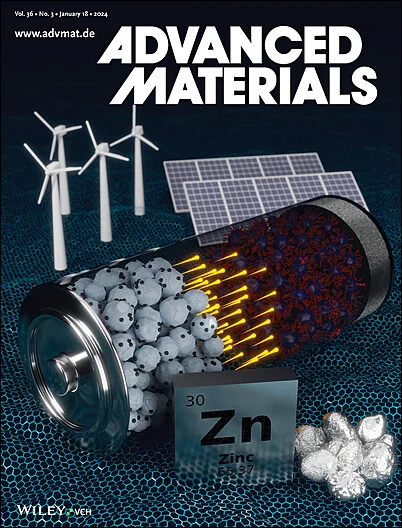Stiff yet Tough, Moisture-Tolerant, Room Temperature Self-Healing and Thermoconductive Biomimetic Nanocomposites.
IF 26.8
1区 材料科学
Q1 CHEMISTRY, MULTIDISCIPLINARY
引用次数: 0
Abstract
Stiff yet room-temperature self-healing polymers are designed using molecularly engineered hydrogen bonds (H-bonds). However, they often suffer from high brittleness, moisture sensitivity, and limited functionality. To overcome these challenges, high-performance biomimetic nanocomposites inspired by inverse nacre structures are developed. A layered boron nitride nanosheet (BNNSs) skeleton is embedded within a previously synthesized room-temperature self-healing glassy polyurethane network, leveraging a solvent exchange-induced self-assembly strategy. This approach resolved the problem of BNNSs agglomeration and reconstructed robust yet dynamic noncovalent interfacial interactions, maximizing the reinforcing and toughening effects of BNNSs. Consequently, the nanocomposite exhibited significant mechanical enhancements, including 6.6-fold, 14.4-fold, 490-fold, and 35.7-fold increases in flexural modulus, strength, toughness, and fracture toughness, respectively, achieving a balance between stiffness and toughness. Furthermore, the nanocomposite retained room-temperature self-healing properties through the secondary relaxation of H-bonds. The impermeability of BNNSs effectively shielded H-bonds from moisture, fundamentally altering the hygroscopic nature of self-healing glassy polyurethanes. Additionally, the highly oriented and interconnected BNNSs skeleton endowed the nanocomposite with an in-plane thermal conductivity of up to 11.54 W m-1 K-1, making it a promising candidate for next-generation high-performance intelligent thermal interface materials.硬而坚韧,耐湿,室温自愈和热传导仿生纳米复合材料。
使用分子工程氢键(h -键)设计了坚硬的室温自愈聚合物。然而,它们经常遭受高脆性,湿气敏感性和有限的功能。为了克服这些挑战,开发了受逆珍珠层结构启发的高性能仿生纳米复合材料。层状氮化硼纳米片(BNNSs)骨架嵌入先前合成的室温自修复玻璃聚氨酯网络中,利用溶剂交换诱导的自组装策略。该方法解决了BNNSs的团聚问题,重建了坚固而动态的非共价界面相互作用,最大限度地提高了BNNSs的增强和增韧效果。因此,纳米复合材料表现出显著的力学增强,包括弯曲模量、强度、韧性和断裂韧性分别增加6.6倍、14.4倍、490倍和35.7倍,实现了刚度和韧性之间的平衡。此外,通过氢键的二次弛豫,纳米复合材料保留了室温自愈特性。BNNSs的不渗透性有效地保护了氢键免受水分的侵害,从根本上改变了自愈玻璃聚氨酯的吸湿性。此外,高度定向和互连的BNNSs骨架赋予纳米复合材料高达11.54 W m-1 K-1的面内导热系数,使其成为下一代高性能智能热界面材料的有希望的候选者。
本文章由计算机程序翻译,如有差异,请以英文原文为准。
求助全文
约1分钟内获得全文
求助全文
来源期刊

Advanced Materials
工程技术-材料科学:综合
CiteScore
43.00
自引率
4.10%
发文量
2182
审稿时长
2 months
期刊介绍:
Advanced Materials, one of the world's most prestigious journals and the foundation of the Advanced portfolio, is the home of choice for best-in-class materials science for more than 30 years. Following this fast-growing and interdisciplinary field, we are considering and publishing the most important discoveries on any and all materials from materials scientists, chemists, physicists, engineers as well as health and life scientists and bringing you the latest results and trends in modern materials-related research every week.
 求助内容:
求助内容: 应助结果提醒方式:
应助结果提醒方式:


